Text Only Timelines
1940s
Yalta Conference
February 4-11, 1945
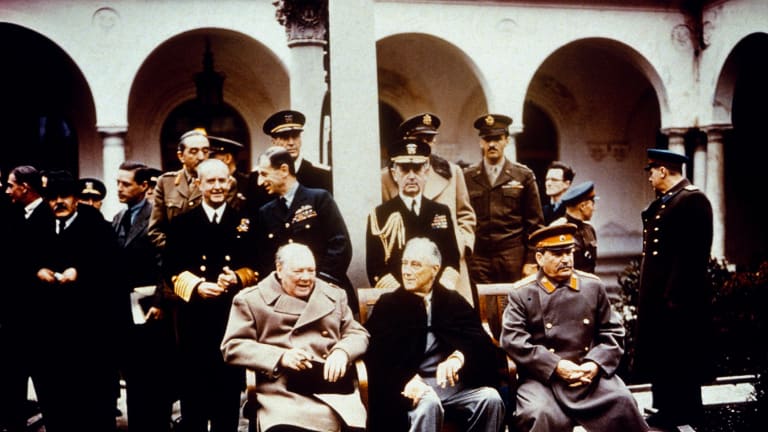
The United States, the United Kingdom, and the Soviet Union were the three major allies in World War II against Nazi Germany. The leaders of each country met in the Soviet Union to discuss the postwar reorganization of Europe and decided to divide Germany and its capital city of Berlin into four zones of occupation under the American, British, French, and Soviet militaries. The Yalta Conference set the stage for economic, ideological, and political tensions between East and West.
United States Drops the Atom Bomb
August 6, 1945
The United States dropped the first atomic bomb on the city of Hiroshima, Japan, on August 6, 1945, killing 70,000 people. Another bomb was dropped on August 9 on the city of Nagasaki, killing 20,000 people. Thousands more Japanese citizens died from radiation from the blasts. US President Harry Truman believed that dropping the atomic bomb would end World War II quickly and give the United States an advantage over the Soviet Union in the postwar era.
Winston Churchill's Iron Curtain Speech
March 5, 1946

The Marshall Plan
June 4, 1947
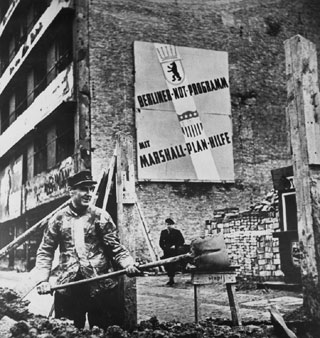
US Secretary of State George C. Marshall introduced a plan to provide American financial aid to Europe for rebuilding after World War II, and the money was intended to be used to buy American goods. Soviet leader Joseph Stalin pressured Eastern European countries to refuse the aid in order to limit “American imperialism” and economic dominance in Europe.
Communist Takeover in Czechoslovakia
February 1948
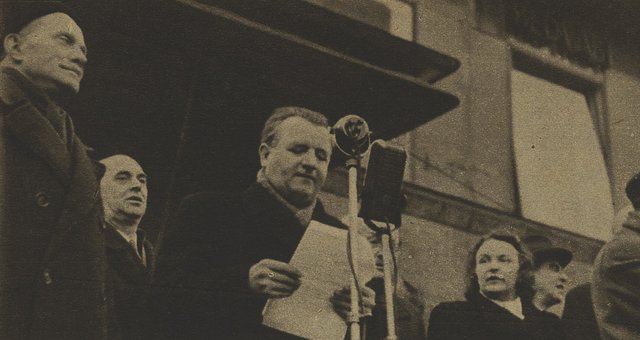
The announcement of the Truman Doctrine promising American economic and military support to countries “threatened by communism” led to turmoil in the Eastern bloc. Communists in Czechoslovakia supported by the Soviet Army overthrew the democratic government and replaced President Edvard Benes with the leader of the local Communist Party, Klement Gottwald.
Division of Germany
Fall 1949
The leaders of the American, British, and French zones of occupation in Germany oversaw the creation of the German Federal Republic (FRG, or West Germany) on September 21, 1949. The Soviets oversaw the creation of the German Democratic Republic (GDR, or East Germany) from their occupational zone on October 7, 1949. The United States supported West Germany and did not recognize the legitimacy of East Germany until 1974.
Ratification of the North Atlantic Treaty Organization (NATO)
April 1949 — July 1949
The United States formed an economic and security alliance with 11 other Western European nations to limit the expansion of communism and deter a Soviet attack. The North Atlantic Treaty Organization, or NATO, still exists today. NATO helped secure the division of Europe and was the West’s main source of military strength against the Soviet Union. The formation of NATO and Soviet anger in response exemplified the atmosphere of mutual distrust between East and West.
Soviet Scientists Detonate Atomic Bomb
August 29, 1949
The successful explosion of the atomic bomb in Soviet Kazakhstan challenged American technological supremacy in the atomic age and increased fears of espionage and the passing of secrets about the US atomic program. In response to the Soviet possession of the atomic bomb, the United States began developing the more powerful hydrogen bomb.
Chinese Revolution of 1949
October 1, 1949
The postwar civil war between the Chinese Communist Party and the Nationalist Party in China ended when communist leader Mao Zedong declared the creation of the People’s Republic of China. The United States refused to recognize or maintain diplomatic relations with the People’s Republic of China until the 1970s.
1950s
Beginnings of McCarthyism
February 1950
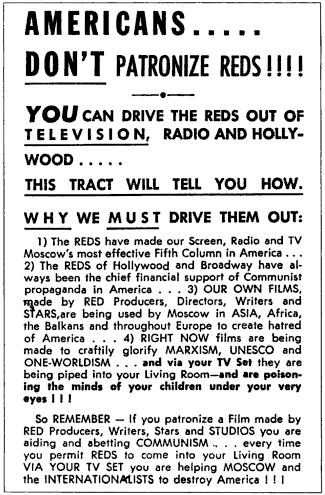
An example of anti-communist literature of the 1950's.
Senator Joseph McCarthy from Wisconsin started a campaign against alleged communists and their supporters as the United States became increasingly concerned about the threat of spies during the “Red Scare.” The campaign was referred to as “McCarthyism” and was characterized by the fact that most people were accused without evidence and subsequently blacklisted, fired, or even arrested.
Korean War
June 25, 1950 – July 1953
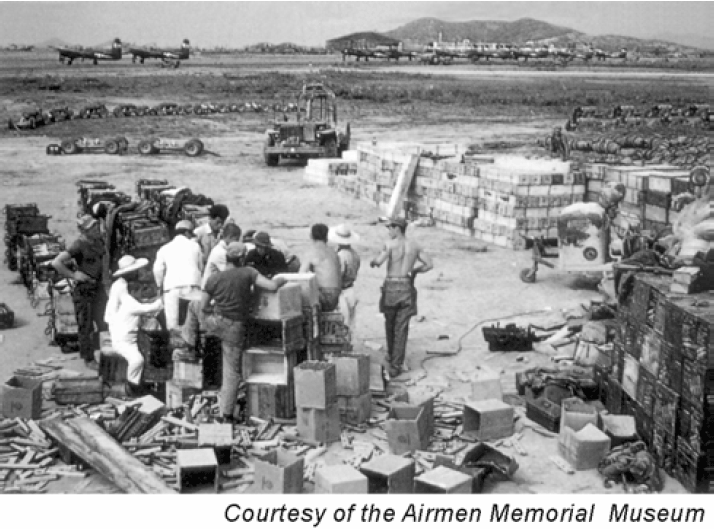
Combat Command Personnel and Supplies in the Korean War, 1950-1952. Wikimedia Commons.
The Korean War began when the army of the Democratic People’s Republic of Korea (North Korea) invaded the Republic of Korea (South Korea). As North Korea was supported by the Soviet government and the communist People’s Republic of China, the United States entered the war in July 1950 on behalf of South Korea, hoping to prevent the spread of communism.
Civil Defense (CD) in Topeka (Local)
1951
Civil defense programs were designed to help prepare Americans for the possibility of nuclear war. The Topeka-Shawnee County civil defense program built a courthouse with an underground bomb shelter in case of a nuclear attack. The CD program aimed to organize mass evacuation during an attack. However, the Shawnee courthouse was intended as a shelter for only about 130 state officials to keep the state of Kansas running during an emergency.
Rosenbergs Executed for Espionage
June 19, 1953

Julius and Ethel Rosenberg, separated by heavy wire screen, after being found guilty.
During the height of McCarthyism, Julius and Ethel Rosenberg were put on trial as spies for passing US atomic secrets to the Soviet Union. While the Rosenbergs insisted upon their innocence, both were sentenced to death for espionage by electric chair.
Formation of the Warsaw Pact
May 14, 1955
The Soviet Union and several East European countries formed a political and military alliance known as the Warsaw Treaty Organization, or Warsaw Pact. It was established to balance power in Europe amid Soviet fears about civil unrest in its satellite states and the strengthening of the North Atlantic Trade Organization (NATO).
Khrushchev’s Secret Speech
February 25, 1956
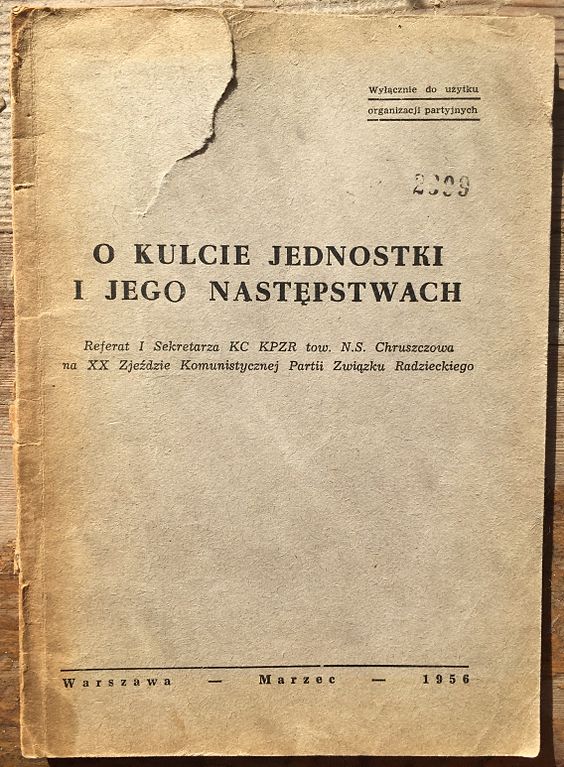
First edition of Khrushchev’s “Secret Speech” in Polish, March 1956. Wikimedia Commons.
In a secret speech at the meeting of the 20th Congress of the Communist Party of the USSR, Soviet leader Nikita Khrushchev denounced Stalin’s “cult of personality” and some of the crimes of his dictatorship. The secret speech led to political reforms in the Soviet Union and unrest in central Europe.
Hungarian Revolution
October-November 1956

Imre Nagy (center), October 13, 1956. Wikimedia Commons.
In the aftermath of Khrushchev’s Secret Speech, a popular uprising in demand of political reforms resulted in a change of leadership in communist Hungary. When new leader Imre Nagy threatened to withdraw Hungary from the Warsaw Pact, the Soviet Union used military force to end the rebellion.
Launch of Sputnik and Beginning of the Space Race
October 4, 1957

Sputnik Satellite, 1957. Wikimedia Commons.
The Soviet Union inaugurated the space age by launching the world’s first artificial satellite, Sputnik, into space. The launching of Sputnik sparked the US-Soviet space race and led to a wave of political, military, technological, and scientific changes.
Founding of the John Birch Society (Local)
December 9, 1958
The John Birch Society was a nation-wide group founded in Indianapolis, Indiana and dedicated to fighting communism and supporting limited government. It was particularly strong in Kansas and used grassroots organization to oppose domestic policies the group associated with communism.
Development of Intercontinental Ballistic Missiles (ICBMs)
August 26, 1957

Launching of the Atlas ICBM at the Vandenberg Air Force Base, California, June 11, 1957. Wikimedia Commons.
The Soviet Union reported the successful launching of a long-range missile one month after an unsuccessful US attempt that crashed shortly after launching. The development of ICBMs fueled Cold War tensions and competition for nuclear and space technology. ICBMs would make it almost impossible for countries to defend themselves against a nuclear attack, as the missiles could travel vast distances in short amounts of time without detection.
Fidel Castro Takes Over Cuba
January 1959

Fidel Castro speaking in Washington, DC.April 15, 1959. Wikimedia Commons.
Fidel Castro was a communist-leaning political figure who participated in the Cuban Revolution. He became leader of the country after helping overthrow the government of Fulgencio Batista. The United States opposed Castro and his government due to fears about the spread of communist revolution in Latin America.
“Kitchen Debate”
July 24, 1959

Kitchen Debate, July 24, 1969. Wikimedia Commons.
At the American National Exhibit in Moscow, US Vice President Richard Nixon and Soviet leader Nikita Khrushchev debated the merits of the American and Soviet political systems while standing in the kitchen of a model of an American home.
Khrushchev’s Visit to the United States
September 15, 1959

Soviet Premier Nikita Khrushchev enthusiastically holds up corn at the Garst Family Farm in Coon Rapids, Iowa. Life magazine, October 5, 1959.
Nikita Khrushchev became the first Soviet leader to visit the United States. During his two-week tour of America, Khrushchev vowed to pursue friendship and peaceful relations between the United States and Soviet Union. His visit helped temporarily ease international tensions and soften the image of the Soviet Union as the “enemy,” especially after his visit to a family farm in rural Iowa.
1960s
Soviet Union Launches First Man into Space
April 12, 1961

Yuri Gagarin in the Vostok, April 12, 1961. Wikimedia Commons.
Soviet astronaut Yuri Gagarin became the first man in space on board the Soviet Union’s Vostok spacecraft. The USSR considered Gagarin’s voyage a symbol of the superiority of communism over capitalism, as each system strove to demonstrate which could produce better advances in technology. Rockets used in space exploration were also built with advances in missile technology in mind.
Bay of Pigs Invasion
April 17, 1961

Douglas A4D-2 Skyhawk aircraft from “Blue Blasters” Squadron over Bay of Pigs, April 1961. Wikimedia Commons.
In 1960, US President Dwight D. Eisenhower’s administration used the Central Intelligence Agency to train Cuban exiles to overthrow Fidel Castro and set up a non-communist government in Cuba. President John F. Kennedy later approved the plan, but the invasion at the Bay of Pigs was met immediately by counterattacks and failed to overthrow the Castro regime.
Construction of the Berlin Wall
August 13, 1961

Construction of Berlin Wall. Wikimedia Commons.
The German Democratic Republic (GDR, or East Germany) constructed the Berlin Wall, dividing East and West Berlin. The wall was erected amid fears of an economic crisis in East Germany to prevent mass emigration and defection. The wall separated families and came to symbolize the broader divisions between the East and West.
Wider Construction of Bomb Shelters (Local)
October 1961
Local businesses in Kansas reported the increased sales of materials for nuclear fallout shelters, while locals received instructions for converting tornado cellars into bomb shelters. The Lawrence Junior Chamber of Commerce built a model fallout shelter for display, demonstrating the extent to which rural America feared nuclear war.
Cuban Missile Crisis
October 1962
The Cuban and Soviet governments made a secret agreement to allow Soviet nuclear missiles in Cuba to prevent future invasion attempts after the Bay of Pigs. This escalated US-Soviet tensions and raised the threat of nuclear war, but the crisis was resolved when the Soviet government agreed to remove missiles from Cuba if the United States promised not to invade Cuba again. The United States also secretly agreed to remove some of its own missiles from Turkey, which bordered the Soviet Union.
Nuclear Test Ban Treaty
August 5, 1963
The United States, the Soviet Union, and the United Kingdom signed a treaty banning the testing of nuclear weapons in air, space, and water. Although continued testing was allowed underground, the treaty was considered a successful step towards peace and environmental protection.
Gulf of Tonkin Incident
August 1964
After forces of the communist government in North Vietnam attacked two US war ships stationed in the Gulf of Tonkin, President Lyndon B. Johnson called for increased US military presence in Indochina. The incident led to the decision nearly a year later to send 150,000 US troops to Vietnam.
Polaris Missile Constructed in Centennial Park (Local)
August 13, 1964

Polaris Missile in Centennial Park, Lawrence, Kansas. June 2020. Photo by Alana Holland.
The US Navy gave a discontinued UGM-27 Polaris missile to the city of Lawrence, Kansas, where it was placed as a monument in Centennial Park. The gift of the rocket reflected the fact that Kansas was a place where local airfields were used as strategic training bases and command centers, emphasizing the geographical importance of the largely rural state during the Cold War.
US Marines Sent to Dominican Republic
April 28, 1965
US President Lyndon B. Johnson sent 22,000 US troops to quell unrest in the Dominican Republic after the assassination of anti-communist dictator Rafael Trujillo and the ouster of liberal leader Juan Bosch. The United States helped install a new government amidst fears of a “communist dictatorship.”
Soviet Invasion of Czechoslovakia
August 20, 1968

Czechoslovaks carry national flag past burning Soviet tank, 1968. Wikimedia Commons.
Troops from the Soviet Union and other Warsaw Pact countries invaded Czechoslovakia to crack down on political reforms and maintain Soviet control of the Eastern bloc. The Soviet Union feared that other communist countries in Eastern Europe and republics within the Soviet Union would also demand reforms or independence.
Apollo 11 Lands on the Moon
July 20, 1969

Photograph of Astronaut Buzz Aldrin taken by Neil Armstrong, July 20, 1969. Wikimedia Commons.
On May 25, 1961, a month after the Soviets successfully launched the first man in space, US President John F. Kennedy vowed to surpass the Soviet space program and to put a man on the moon by the end of the 1960s. After the successful landing of the Apollo 11 rocket, US astronaut Neil Armstrong became the first human to walk on the moon and put the United States ahead in the space race.
1970s
United States Helps Overthrow Chilean Government
September 1973
Due to the fear of the spread of communism and Soviet influence in South America, US President Richard Nixon and advisor Henry Kissinger used the CIA to back a military coup overthrowing Chile’s democratically elected president.
End of Vietnam War
April 30, 1975

Vietnam War protestors in Wichita, Kansas, 1967. Wikimedia Commons.
The United States entered the Vietnam War to prevent the spread of communism in Southeast Asia but ended its involvement after a peace agreement in 1973. US withdrawal led to the reunification of North and South Vietnam under a communist government.
University of Kansas Jayhawks vs. Soviet National Basketball Team at Allen Fieldhouse (Local)
Fall 1978

University of Kansas Men's Basketball Game vs. Soviet Union, 1978-1979. University of Kansas Libraries Digital Collections, University Archives.
Throughout the 1970s and 1980s, the Soviet national basketball team played in televised exhibition games against American colleges, including the University of Kansas and Wichita State University. While highlighting the rivalry between the United States and the Soviet Union, exhibition games also fostered friendship among Cold War enemies through sports.
Iranian (or Islamic) Revolution
February 11, 1979

Women protesting during the Iranian Revolution, 1979. Wikimedia Commons.
Popular resentment of economic and social policies fueled the overthrow of the Shah of Iran, Mohammad Reza Pahlavi, and the establishment of the Islamic Republic. The United States lost Iran as a strategic ally after the revolution but built up its forces in surrounding Middle Eastern countries.
Strategic Arms Limitations Talks (SALT II) Treaty
June 18, 1979
In the interest of peace, the Soviet Union and United States pursued a series of negotiations and agreements intended to limit nuclear weapons beginning in 1972. The United States and the USSR signed a treaty limiting the kind and number of nuclear weapons that could be developed.
1980s
The Strategic Defense Initiative (SDI)
March 23, 1983
US President Ronald Reagan proposed a program to develop technology for detecting and deflecting nuclear missiles heading toward the United States. Despite the technological difficulties and criticism of SDI, the US government spent billions of dollars on the program in hopes of safeguarding against the nuclear threat.
Release of Film The Day After (Local)
November 20, 1983
The Day After was a television film set in Lawrence, Kansas that depicted the consequences of nuclear war. The film was seen by over 100 million people and spoke to the fears ordinary Americans had about the threats of nuclear war and the consequences of high-power politics. Many local residents had small roles in the film and it had a deep impact in Lawrence and the nation at large.
Iran-Contra Affair
1985
US President Ronald Regan agreed to a secret request on behalf of Iran to buy weapons from the United States in exchange for American hostages. More than half of the $30 million paid by the Iranian government for weapons was covertly used to support anti-communist insurgents in Nicaragua.
The Reykjavik Summit
October 11 and 12, 1986
US President Ronald Reagan and Soviet Premier Mikhail Gorbachev both hoped to reduce and eventually eliminate nuclear weapons. While the two leaders failed to come to an agreement at the summit, their meeting paved the way for future negotiations that lessened the threat of nuclear war.
Glasnost and Perestroika in the Soviet Union
1986

Soviet rock musician Viktor Tsoi, Moscow, 1986. Wikimedia Commons.
Soviet Premier Mikhail Gorbachev instituted a program of economic, political, and social restructuring (perestroika) and a policy of openness (glasnost). Although Gorbachev intended to create greater economic and political freedoms in the Soviet Union, the reforms destabilized the economy and paved the way for civil unrest.
Soviet Withdrawal of Troops from Afghanistan
January 1989
The Soviet Union had invaded Afghanistan in December 1979 to support the communist government that came to power after the overthrow of President Mohammaud Daud Khan. The United States supplied weapons to anti-government insurgency groups (mujahideen) in Afghanistan. By the end of the Afghan War, two million civilians had died as well as 15,000 Soviet soldiers.
Fall of the Berlin Wall
November 9, 1989
A man juggling on top of the Berlin Wall after the opening of the border between East and West Germany, November 16, 1989. Wikimedia Commons.
In the aftermath of revolutions in Hungary and Poland in 1989, the East German government announced a plan to loosen restrictions on travel to West Germany. Thousands of East Germans then began to dismantle the Berlin Wall. Its destruction symbolized the beginning of the end of communist rule in Eastern Europe.
1990s
Lithuania Declares Independence
March 11, 1990

Lithuanians participate in a singing protest in 1989. Wikimedia Commons.
Lithuania became the first Soviet republic to declare its independence. In response, Soviet troops occupied the capital city of Vilnius and in January 1991 used military force to suppress the independence movement, resulting in 14 civilian deaths.
Lawrence Meeting for Peace (Local)
October 12-18, 1990

Lawrence Meeting for Peace poster, 1990. Photo courtesy of Robert Swan, Jr.
Robert Swan, Jr. was a local leader in Lawrence who organized multiple events bringing Kansans and Soviet citizens together in the 1980s, including the Kansas Relays in 1983. About 300 Soviet citizens visited Lawrence and six other Kansas cities during the 1990 Meeting for Peace, which sponsored conferences and art shows for the Soviet visitors who stayed with local Kansas families.
Reunification of Germany
October 3, 1990
After 45 years of separation, East and West Germany were reunited. Despite the significance of the reunification, the following decade was marked by lingering economic problems and social tensions between former East and West Germans.
Failed August Coup
August 19-22, 1991

Defenses constructed by Muscovites to oppose the August Coup. Wikimedia Commons.
The August Coup was a final attempt to oppose the democratization unleashed by Gorbachev’s reforms. Communist leaders who opposed recent political and social reforms tried to oust Gorbachev and take control of the country. The coup had very little popular support and ultimately failed, leading to the collapse of the Communist Party. Several Soviet republics declared independence in the aftermath of the coup.
Collapse of the Soviet Union
December 25, 1991
The destabilization of communist rule in the aftermath of Mikhail Gorbachev’s decision to allow multi-party elections and the demands for independence from republics in the Baltics and Caucasus led Gorbachev to resign as leader of the Soviet Union. Boris Yeltsin became President of the independent Russian state and the Soviet Union dissolved into twelve independent republics.
